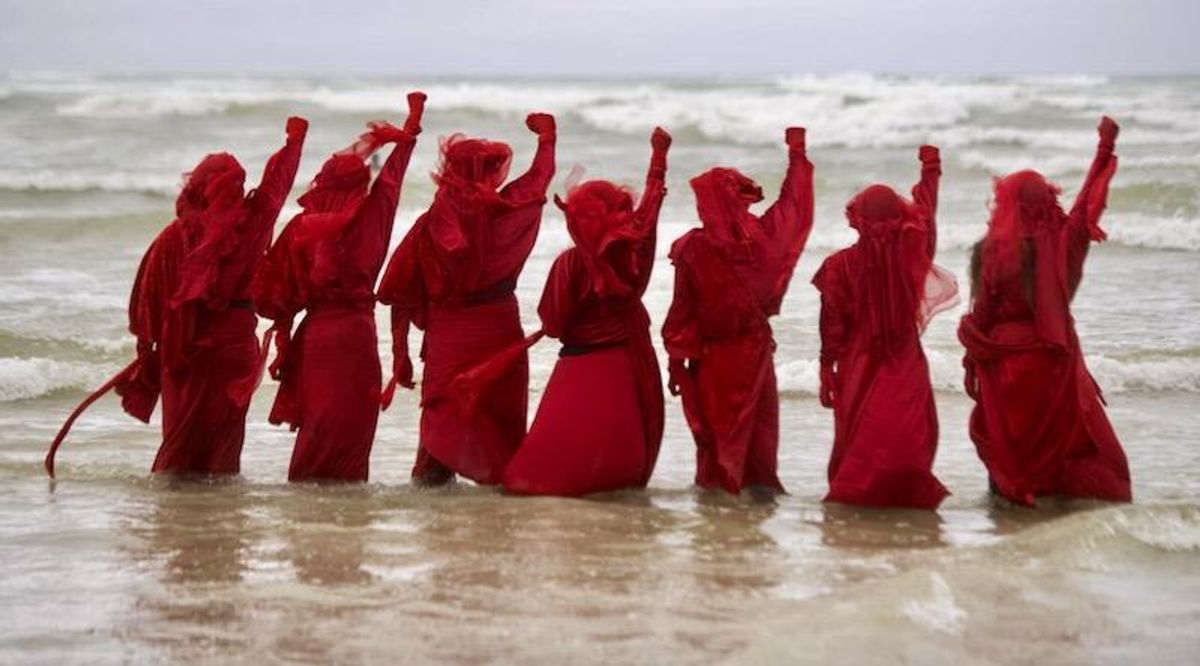Ian Max Stevenson, The Idaho Statesman -
On Nov. 8, incumbent Gov. Brad Little, who won the Republican nomination in the primary, faces an insurgent candidate with national name recognition.
Ammon Bundy, a Nevada native, switched to independent on the ticket earlier this year and has run a campaign to abolish property and income taxes, cut welfare programs and privatize public lands. In campaign ads, he has also called abortions in the U.S. the greatest genocide in history, suggested “liberals” are in a cult and said he would help them leave the state.
Bundy has become widely known in Idaho since the start of the pandemic in his fight against business closures, vaccine mandates and public health precautions. He has been arrested at the Idaho Capitol multiple times, and was sued by St. Luke’s Health System for protesting state custody of a child believed to be in ill health, which led the hospital to shut down for over an hour.
But Bundy was known before the pandemic, too. In 2014, after Bundy’s father, Cliven Bundy, refused to pay public land grazing fees for over two decades, federal agents with the Bureau of Land Management attempted to remove his cattle. Members of militias and others from across the country gathered in Nevada to protest the removal, and an armed standoff ensued.
After protesters aimed guns at outnumbered police and federal agents, the agents stood down. Ammon, Cliven and other Bundy family members faced several federal charges. The case was dismissed in 2018, after a judge said prosecutors withheld important evidence from the defense.
In 2016, Bundy led a group of armed protesters to take over the Malheur National Wildlife Refuge in Oregon. Following weeks of occupation, one protester — LaVoy Finicum — was shot and killed after trying to drive through a police roadblock and, according to the FBI, reaching for a weapon inside his coat.
Ammon and his brother, Ryan, were among those who faced federal charges for the takeover. Later that year, they were acquitted.
In her 2019 book, “American Zion,” Betsy Gaines Quammen, an environmental historian, examines how the history of settlement in the West by members of the Church of Jesus Christ of Latter-day Saints connects to the Bundy family’s views of land ownership, property rights and the role of government.
Last year, Gaines Quammen was a writer-in-residence at the Ernest and Mary Hemingway House and Preserve in Ketchum to work on a new project, “True West: Myth and Mending on the Far Side of America.” In it, the writer, who lives in Bozeman, Montana, is exploring rising polarization in the West, and looking for ways to reconcile people with different political ideologies and bring them back into relationship with each other.
She spoke to the Idaho Statesman recently. The transcript has been edited for brevity and clarity.
Bundy did not immediately respond to a request for comment.
Could you tell me a bit about your research on the Bundys and how the family’s history connects to the history of the West?
“I’m very interested in how people perceive landscape based on their religious points of view. I began to look at the LDS settlement in the West and what ideas were brought with settlement. There was a real effort to establish a place that this new religion could practice without feeling oppression. In terms of the way land is viewed now, it’s important to understand that package of things that were bundled in the idea of Zion.”
How did the Bundys then fit into that picture?
“There’s a lot of layers here. There’s the religious significance of the U.S. Constitution. There is the idea that as a landscape is considered promised, what that means in terms of a religious obligation to utilize it. There are also texts or revelations that you can find in Mormon history that it’s incumbent upon a member of the church to be the hero, to protect the Constitution. You have prophecy, you have religious significance of the Constitution, you have the way that land is utilized, which all have religious implications. The Constitution is essentially part of a sacred canon. I think you’re seeing that in Idaho — and it’s not just LDS — but it is a part of what informs the Bundy family.”
Who is Cliven Bundy and what are his views of land and how it should be used, settled or otherwise?
“He doesn’t feel like the government is entitled to own land. He really sees his area that he operates in as being his. It’s interesting to think about what is religious and what has just become the way the family sees the government. There is a real anti-government history in the church. They were trying to escape the U.S. government.
There were real reasons why they had experienced bigotry. When they went to the Great Basin, it was Mexico. And so they really felt like they were going to have this autonomy. I think it informs the way they see land, that you have this history of anti-government sentiment that continued throughout generations, especially in rural places in these areas that were settled by Mormons. There’s a history of anti-government sentiment, there is a history of generation, after generation, after generation of Mormon land use. There is a belief that if you cultivate land, you are actually pleasing the eye of God.
The idea of undeveloped land or wilderness is an antithesis to what Mormon worldview sees as appropriate ways to utilize land. And then you have the fact that there were environmental laws passed. Some of these acts like (the National Environmental Policy Act), (the Federal Land Policy and Management Act), the Endangered Species Act, there was a real response across the West. It wasn’t just LDS, but this was land that they had been utilizing without any regulations, and all of a sudden regulations were coming in and impacting the way that they ranched.
Cliven told me that, essentially, Jesus wrote the Constitution, and it’s divinely inspired. That means that your rights are somehow sacred, and you have this layer that it’s important as a LDS member of the church to fight to protect the Constitution. Cliven has over and over again suggested that his effort is part of a holy war. It’s a bundle of things. It’s libertarianism, it’s this very, very specific way of seeing Mormon worldview.
I think it’s important to say, they do not represent the church. And in fact, the church has at times, during the Malheur takeover, they really came out and said, don’t use scripture to justify what you’re doing. You have these notions that this is my right and it’s my right because it’s God-given, and I also want to graze my cows here.”
Ammon Bundy is running for Idaho governor. But he was a national figure well before this. I wondered if you could tell me a bit about why he’s a national figure, what he stands for and some of these views you were describing Cliven having — whether you think Ammon basically agrees with those or whether there are any kind of key differences between the two of them.
“I think he really reflects his father’s beliefs. The battle of Bunkerville, which was the Nevada standoff, that was something that I think really galvanized the militia movement.
The Malheur takeover was not supported by most militia groups that had participated in the Nevada standoff. The death of LaVoy Finicum changed the way the Oregon takeover was viewed in this culture — suddenly it validated the idea that the federal government was the oppressor. Although Finicum resisted arrest, some saw his death as murder that legitimized the occupation. It gave Ammon’s actions credibility.
Ammon, I think, he’s very mission driven. And I think that’s partially — well, I think that’s a lot — religious. He was looking for his next thing. He was involved with a family that was being evicted (in Idaho), he put out the word, but then he realized that the family had for a long time not been paying their mortgage. And so he abandoned that. He had established People’s Rights Network before COVID, but the membership swelled with the COVID stay-at-home, shelter-in-place measures. COVID became a central thing. Now it’s running for governor.
I think he’s looking for his mission, and he keeps turning towards ways that he can fulfill these both religious and political, what he sees as obligations.”
You’ve been researching militia and anti-government movements in the West. What influence do you think Bundy has in those circles and how do these ideas connect to some of these other movements in the West, whether they’re Christian nationalist or other kinds of movements?
“They very much connect because the militia movement has really been inspired by the actions of the Bundy family. The Three Percenters, the Oath Keepers, they both had a presence in Nevada at the standoff, and I think the Bundy family has inspired them. They see themselves protecting people’s rights, and they feel like the Bundy family’s rights have been violated.
Think of you renting an apartment. Your landlord comes to you one day and says, ‘You gotta move out, but I’ll pay you.’ That’s really what happened. And so this wasn’t a violation of rights. Actually they were being compensated to give up what’s not even an inherent right. The militia movement was galvanized over people who were being compensated to give up a lease.”
After Nov. 8, we’ll know who won the governor’s race in Idaho. Even if Bundy loses, what do you think the future holds for figures like him and the movement he leads?
“I feel like they still have momentum. I feel like they’re gaining power. They definitely have people’s attention.
You now have Dorothy Moon who is head of the Republican Party. She very much is part of this network of figures that includes Ammon Bundy. As long as the Idaho Freedom Foundation and organizations like it continue to have power, you’re going to continue to see figures like Ammon Bundy be in the public eye in some capacity.”
©2022 The Idaho Statesman. Visit idahostatesman.com. Distributed by Tribune Content Agency, LLC.



/cdn.vox-cdn.com/uploads/chorus_image/image/71584033/GettyImages_1239416791.0.jpg)

